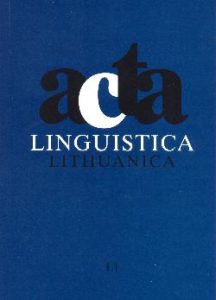Grammatische Kernbereiche, deren Rekonstruktion und deren Relevanz für historisch belegte Sprachstufen des Baltischen und ...
Nuclear domains of grammar, their reconstruction and their significance for research into the historically attested development stages of Baltic and..
Author(s): Björn WiemerSubject(s): Language and Literature Studies
Published by: Lietuvių Kalbos Institutas
Keywords: Baltic; Slavic; language change; voice; alignment; aspectuality
Summary/Abstract: The paper offers a critical account of prominent theoretical approaches to prehistorical developments of basic morphosyntax in Baltic and Slavic: voice, alignment and aspectuality. For comparative reasons the relation between possessive BE- and HAVE-constructions is discussed as well. The methodological practice in reconstructing and explaining the diachronic evolution of ancient Baltic and Slavic is assessed critically, first of all because it has abided by ‘in vitro’-approaches without an account of language contact and typological evidence. It is argued that an adequate theory of grammatical change would further have to try to be more accurate with respect to the relative chronology of ‘layers’ of coding techniques and their possible intersections during long periods of diachronic development. This includes the possibility of the co-occurrence of grammatical coding. As for this issue, speakers of contact languages could trigger the functional repartition of such cooccurrent devices to such a degree that one of these devices would become predominant, fitting their own language’s form : function distribution.
Journal: Acta Linguistica Lithuanica
- Issue Year: 2004
- Issue No: 51
- Page Range: 81-113
- Page Count: 34
- Language: German

